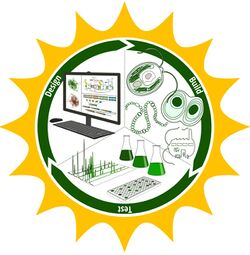Difference between revisions of "Synthetic biology"
(import from Wikipedia) |
(mark as too shallow) |
||
| Line 1: | Line 1: | ||
| − | {{concept | + | <div style="border:2px solid #3333ff; background-color:#ccccff; padding:0.4em 0.5em; margin:auto; width:40%; text-align:center;"> |
| + | [[File:too shallow.png|left|72px]]'''This page is too shallow.'''<br/> {{{1|It only has the [[official narrative]] and needs a more skeptical, [[deep political]] perspective.}}}</div>{{concept | ||
|wikipedia= | |wikipedia= | ||
|start= | |start= | ||
|image=Humberto-1.jpg | |image=Humberto-1.jpg | ||
| − | |description=An area of research that | + | |description=An area of research that claims to be able to create new biological parts, devices, and systems, or to redesign systems that are already found in nature. This contrasts with "traditional" [[genetically modified organism]]s created by transferring existing genes from one cell type to another. |
|constitutes=medical technology,biotechnology | |constitutes=medical technology,biotechnology | ||
}} | }} | ||
'''Synthetic biology''' ('''SynBio''') is an area of research that seeks to create new biological parts, devices, and systems, or to redesign systems that are already found in nature. This contrasts with "traditional" [[genetically modified organism]]s created by transferring existing genes from one cell type to another. | '''Synthetic biology''' ('''SynBio''') is an area of research that seeks to create new biological parts, devices, and systems, or to redesign systems that are already found in nature. This contrasts with "traditional" [[genetically modified organism]]s created by transferring existing genes from one cell type to another. | ||
| − | + | ==Official narrative== | |
| + | Biology claims to be able to re-designing genes, cells, or organisms for [[gene therapy]]; development of [[minimal cell]]s and artificial [[protocell]]s; and development of organisms based on [[Xenobiology|alternative biochemistry]].<ref name=":0">https://blogs.cdc.gov/niosh-science-blog/2017/01/24/synthetic-biology/</ref> | ||
This work has been driven by the development of [[Artificial gene synthesis|genome synthesis]] and [[CRISPR gene editing|editing tools]], as well as pools of standardized [[synthetic biological circuit]]s with defined functions. The availability of these tools has spurred the expansion of a [[do-it-yourself biology]] movement.<ref name=":3">https://publications.europa.eu/en/publication-detail/-/publication/bfd7d06c-d3ae-11e5-a4b5-01aa75ed71a1/language-en</ref> | This work has been driven by the development of [[Artificial gene synthesis|genome synthesis]] and [[CRISPR gene editing|editing tools]], as well as pools of standardized [[synthetic biological circuit]]s with defined functions. The availability of these tools has spurred the expansion of a [[do-it-yourself biology]] movement.<ref name=":3">https://publications.europa.eu/en/publication-detail/-/publication/bfd7d06c-d3ae-11e5-a4b5-01aa75ed71a1/language-en</ref> | ||
| Line 16: | Line 18: | ||
Due to more powerful [[genetic engineering]] capabilities and decreased DNA synthesis and [[DNA sequencing|sequencing costs]], the field of synthetic biology is rapidly growing. In 2016, more than 350 companies across 40 countries were actively engaged in synthetic biology applications; all these companies had an estimated net worth of $3.9 billion in the global market.<ref>https://doi.org/10.1016%2Fj.tibtech.2017.02.002 Bueso, F. Y.; Tangney, M. (2017). "Synthetic Biology in the Driving Seat of the Bioeconomy". Trends in Biotechnology. 35 (5): 373–378.</ref> | Due to more powerful [[genetic engineering]] capabilities and decreased DNA synthesis and [[DNA sequencing|sequencing costs]], the field of synthetic biology is rapidly growing. In 2016, more than 350 companies across 40 countries were actively engaged in synthetic biology applications; all these companies had an estimated net worth of $3.9 billion in the global market.<ref>https://doi.org/10.1016%2Fj.tibtech.2017.02.002 Bueso, F. Y.; Tangney, M. (2017). "Synthetic Biology in the Driving Seat of the Bioeconomy". Trends in Biotechnology. 35 (5): 373–378.</ref> | ||
| − | |||
| − | |||
| − | |||
| − | |||
| − | |||
| − | |||
| − | |||
| − | |||
| − | |||
| − | |||
| − | |||
{{SMWDocs}} | {{SMWDocs}} | ||
==References== | ==References== | ||
{{reflist}} | {{reflist}} | ||
| − | |||
| − | |||
| − | |||
| − | |||
| − | |||
| − | |||
Latest revision as of 11:53, 28 March 2024
It only has the official narrative and needs a more skeptical, deep political perspective.
(medical technology, biotechnology) | |
|---|---|
 | |
| Interest of | • Ginkgo Bioworks • Craig Venter |
| An area of research that claims to be able to create new biological parts, devices, and systems, or to redesign systems that are already found in nature. This contrasts with "traditional" genetically modified organisms created by transferring existing genes from one cell type to another. | |
Synthetic biology (SynBio) is an area of research that seeks to create new biological parts, devices, and systems, or to redesign systems that are already found in nature. This contrasts with "traditional" genetically modified organisms created by transferring existing genes from one cell type to another.
Official narrative
Biology claims to be able to re-designing genes, cells, or organisms for gene therapy; development of minimal cells and artificial protocells; and development of organisms based on alternative biochemistry.[1]
This work has been driven by the development of genome synthesis and editing tools, as well as pools of standardized synthetic biological circuits with defined functions. The availability of these tools has spurred the expansion of a do-it-yourself biology movement.[2]
Synthetic biology has potential commercial applications in energy, agriculture, medicine, and the production of chemicals including pharmaceuticals.[1]
Due to more powerful genetic engineering capabilities and decreased DNA synthesis and sequencing costs, the field of synthetic biology is rapidly growing. In 2016, more than 350 companies across 40 countries were actively engaged in synthetic biology applications; all these companies had an estimated net worth of $3.9 billion in the global market.[3]
References
- ↑ a b https://blogs.cdc.gov/niosh-science-blog/2017/01/24/synthetic-biology/
- ↑ https://publications.europa.eu/en/publication-detail/-/publication/bfd7d06c-d3ae-11e5-a4b5-01aa75ed71a1/language-en
- ↑ https://doi.org/10.1016%2Fj.tibtech.2017.02.002 Bueso, F. Y.; Tangney, M. (2017). "Synthetic Biology in the Driving Seat of the Bioeconomy". Trends in Biotechnology. 35 (5): 373–378.
